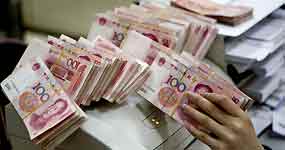
全球失衡的必要调整正在进行中。中国的经常账户盈余从11%的峰值降至2009年的6%左右,同时美国的经常账户赤字也远低于6%的峰值水平。人们正在调低对中国未来盈余的预期。然而,下一个失衡的轮廓正变得清晰起来,而中国的汇率是其中的核心因素。
基本上,流向新兴经济体的资本浪潮面对的只是部分灵活的货币。许多因素造成了这股资本流动潮——这些因素大幅提高了新兴市场相对于发达经济体的资本回报率。
最重要的因素是新兴经济体的截然不同的表现,尤其是正在恢复生机的亚洲国家,而发达经济体(主要是欧洲国家)增长乏力。其结果是,这些资本流动的规模可能超过了危机前的水平。
由于这些经济体处于周期性复苏的不同阶段,它们的货币政策姿态也有所不同。由于通胀仍静止不动,发达经济体的货币政策当局可能只会逐渐退出政策支持。新兴经济体(中国、印度和印度尼西亚)的当局则已经开始收紧货币政策,以抗击初露苗头的通胀压力,或者随着经济恢复增长,正退出早先的宽松货币政策。因此出现了有利于新兴经济体的巨大利差,这进一步推动资本从发达经济体流向新兴经济体。希腊问题及其后来在欧洲的扩散,可能只会加剧资本向新兴经济体的流动。
新兴经济体作出了什么回应?主要是通过大规模积累外汇储备,步伐与危机前的时期类似。问题不在于新兴经济体不允许汇率升值以应对资本流动;而是汇率升值的灵活性一直有限。具有讽刺意味的是,这种政策选择加剧了失衡状况。汇率越不灵活,对资本流动的吸引力就越大,因为政策本身制造了这种单向押注。
如何解决这种失衡?一些资本流动是不可避免的,甚至是可取的,从这个意义上说,新兴经济体必须高度警惕,阻止商品和资产价格过热。这里有理由感到乐观。特别是在亚洲——上世纪90年代后期以及最近金融危机的教训铭刻于各国的集体DNA。上世纪90年代的危机让它们知道不该做什么,而此次金融危机证实了在中间这几年保持审慎是正确的。
但是,无论是从宏观审慎的理由出发,还是为了避免因汇率升值而导致竞争力下降,新兴经济体都会希望减缓资本的流入。他们应该怎么办?唯一两个真正的选择是资本控制和货币升值。但日益明显的是,目前局面充满了以邻为壑政策的可能性。例如,如果一些国家限制资本流动,资本就有可能流向其它国家,从而增加这些国家的压力。随着全球各国的外汇储备增长,竞争性不升值政策——鉴于他们的主要贸易竞争对手中国实施固定汇率政策,许多新兴经济体表现出这种偏好——带来了全球经济过热和过度流动性的巨大系统性损失。
政策方面的教训是明显的:新兴经济体需要协同管理资本流动和汇率。促进这种协同的关键是中国的汇率政策。中国已经暗示人民币汇率将更加灵活,这令人欢迎。但其渐进主义政策可能受到事件的影响。鉴于资本流动的规模,如果中国实施的举措力度不大,其它国家(尤其是亚洲国家)也可能不会实施大的举措。鉴于人民币最终升值幅度的预期,人们基本上将会继续单向押注,这不会对资本流动产生多少削弱效应。
纠正新的失衡将需要中国实施更加雄心勃勃的举措。在中国采取行动后,其它新兴经济体随后可能允许本国货币汇率更加灵活。事实上的政策协作是可能的,而中国迅速而大幅度地采取行动可能有助于这一切的发生。
本文作者为彼得森国际经济研究所(Peterson Institute for International Economics)和全球发展中心(Center for Global Development)高级研究员
译者/何黎
http://www.ftchinese.com/story/001032318

Necessary adjustments in global imbalances are under way. China's current account surplus is down from a peak of 11 per cent to about 6 per cent in 2009, while the US current account deficit is well down from its peak of 6 per cent. Estimates of future surpluses in China are being revised down. Yet the contours of the next imbalance are becoming clear and China's exchange rate is central.
Essentially, the tidal force of capital flows to emerging economies faces only partially flexible currencies. The wave is being caused by a number of factors that have sharply increased returns to capital in emerging markets relative to those in advanced economies.
The biggest factor is the contrasting performance of emerging economies, especially in Asia, which are roaring back, while advanced economies, notably in Europe, are growing anaemically. As a result, the size of these flows is likely to surpass pre-crisis levels.
With these economies at different stages of cyclical recovery, monetary policy stances are also in contrast. With inflation still quiescent, monetary authorities in advanced economies are likely to withdraw policy support only gradually. In emerging economies authorities have started to tighten monetary policies to head off incipient inflationary pressures (China, India and Indonesia) or they are unwinding the earlier monetary accommodation as growth returns. Thus, substantial interest rate differentials in favour of emerging economies are becoming a reality, further pushing capital from advanced to emerging economies. Problems in Greece and consequential contagion in Europe might only aggravate capital flows to emerging economies.
How have emerging economies responded? Essentially through massive accumulation of foreign exchange reserves, the pace of which resembles the pre-crisis period. It is not that emerging economies have not let their currencies appreciate in response to flows; rather, upward currency flexibility has been limited. The irony is that this policy choice worsens the imbalance. The more inflexible exchange rates are, the greater the pull for capital flows because of the one-way bet that is created by policy.
How can this imbalance be resolved? To the extent that some flows are unavoidable and even desirable, emerging economies have to be ultra-vigilant in preventing overheating of goods and asset prices. Here there is reason for optimism. Especially in Asia the lessons from the late-1990s crisis and the recent one have been etched in the collective DNA. The 1990s crisis taught them what not to do, while the financial crisis affirmed the prudent choices made in the intervening years.
But emerging economies will want to moderate inflows of capital both for macroprudential reasons and to avoid becoming uncompetitive due to rising currency values. What should they do? The only two real options are capital controls and currency appreciation. But what is becoming clear is that the landscape is rife with beggar-thy-neighbour possibilities. For example, if some countries restrict capital, there is the risk that capital gets diverted to others, increasing pressure on them. And competitive non-appreciation – the revealed preference of many emerging economies given that their main trade competitor, China, has a fixed exchange rate – imposes large systemic costs, of global overheating and excess liquidity creation, as reserves pile up around the world.
The policy lesson is clear: the need for co-ordination among emerging economies on managing capital flows and exchange rates. Key to facilitating this is China's exchange rate policy. It is welcome that China has signalled that the renminbi will be more flexible. But its policy of gradualism risks being overtaken by events. Given the scale of capital flows, a small move by China will probably only elicit a small move by other countries, especially in Asia. Given expectations about the magnitude of its eventual appreciation, the one-way bet will remain largely intact, with not much dampening effect on flows.
Rectifying the new imbalance will require an even more ambitious move by China. With that in place other emerging economies can then allow more flexibility in their currencies. De facto policy co-ordination is possible and China moving soon and substantially can help bring that about.
The writer is senior fellow at the Peterson Institute for International Economics and Center for Global Development

没有评论:
发表评论